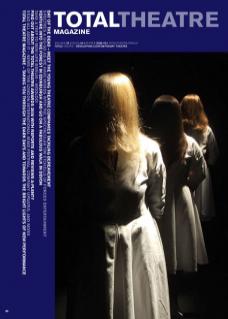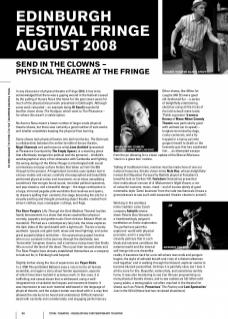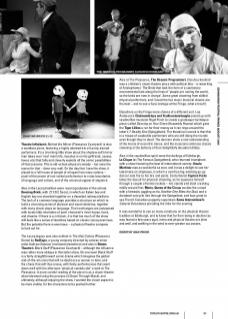In any discussion of physical theatre at Fringe 2008, it has to be acknowledged that there was a gaping wound in the festival caused by the pulling of Aurora Nova (the home for the past seven years for much of the physical/visual work presented in Edinburgh). Although some work relocated – an example being Al Seed’s wonderful bouffon clown show The Fooligan, which went to The Pleasance – for others this wasn’t a viable option.
No Aurora Nova meant a lower number of larger-scale physical theatre shows, but there was certainly a good number of solo works and smaller ensembles keeping the physical fires burning.
Some shows took physical theatre into dark territories. The Gymnast, a collaboration between the enfant terrible of dance-theatre, Nigel Charnock and performance artist Jane Arnfield (presented at Pleasance Courtyard by The Empty Space), is a stunning piece that effortlessly merges the political and the personal – Arnfield’s autobiographical story of her obsession with Cambodia and fighting the wrong-doings of the Khmer Rouge is intermingled with social commentary and pop-culture history that takes us from the 60s through to the present. A fragmented narrative uses spoken text in various modes and voices; carefully choreographed and beautifully performed physical action and movement; an at-times earsplitting soundtrack that merges found sound, recorded political speeches, and pop classics; and a beautiful design – the stage centrepiece is a large, mirrored pagoda-pink wardrobe that revolves and opens, its drawers spilling their contents; the stage becoming the site for a visually exciting and thought-provoking object theatre created from strewn clothes, toys, newspaper cuttings, and flags.
The River People’s Lilly Through the Dark (Bedlam Theatre) tackles family bereavement in a show that mixes vaudevillian physical comedy, puppetry and gentle music (from director Edward Wren on mandolin). Pitched as a contemporary fairy tale, the show explores the dark sides of life (and death) with a light touch. There’s a lovely aesthetic: (purple and gold cloth; straw and steel lighting), and some great puppetry/object animation – the eponymous puppet-heroine who is our constant in this journey through the darklands; two ‘humanette’ hangman clowns; and a luminous rising moon that finally lifts us out of the land of the dead. This is just their second show and The River People have already established themselves as a company to look out for, in Edinburgh and beyond.
Slightly further along the line of experience are Paper Birds. In a 1000 Pieces (Gilded Balloon) sees a return to the all-female ensemble, and again a story about female oppression, aspects of which have been tackled in previous work. In this case, it is trafficking and sexual abuse that is addressed, using a wellintegrated mix of verbatim techniques and movement theatre. It was impressive to see such material addressed in the language of physical theatre, and the subject matter was dealt with in a way that allowed the stories to be heard and understood. Difficult material dealt with carefully and considerately, and engaging performances.
Other shows, like Mime for Laughs (Hill St) were good old-fashioned fun – a series of delightfully entertaining sketches using all the tricks of the (old-school) mime trade. ‘Polish superstar’ Ireneusz Krosny of Mono-Mime Comedy Theatre was particularly good with animals (so to speak) – burglars terrorised by dogs, cocky cockerels, and a fly trapped in a honey pot who gorges himself to death on the heavenly goo that has captivated him… an attempted escape from the jar allowing for a clever update of the Marcel Marceau ‘stuck in a glass box’ routine.
Talking of traditional mime, mention must be made here of one our national treasures, female clown-mime Nola Rae, whose delightfully-named Exit Napoleon Pursued by Rabbits played at Footsbarn’s beautiful tent on Carlton Hill. Footsbarn themselves presented their multicultural version of A Midsummer’s Night Dream, a riot of colourful costume, music, mask – and of course plenty of good commedia-style ‘Zanni business’ from the rude mechanicals (it was a great pleasure to see such well-seasoned theatre clowns in action!).
Working in the wordless mime tradition came Czech company Adriatik whose show Polaris (Zoo Venues) is a heartbreakingly poignant meditation on Arctic exploration. The performers paint the explorers’ world with physical precision, and in a way that cleverly portrays that in such bleak and extreme conditions the external world and the internal self merge into one dreamlike reality. It becomes hard for us to tell where man ends and penguin begins; the sighs of exhaled breath and cries of a distant albatross melt together; and in walking through the blizzard, explorer seems to become blizzard personified. At times it is painfully slow, but I love it all the more for this. Beautiful, melancholy, and sometimes terribly funny. It was also heartening to see Zoo Venues programming so many physical theatre shows, and to see audiences full (often with young adults, a demographic not often reached in the theatre) for shows such as Polaris, Precarious’ The Factory and Lost Spectacles’ Lost in the Wind (these last two reviewed elsewhere).
Theatre Infinitum’s Behind the Mirror (Pleasance Courtyard) is also a wordless piece, featuring a highly talented trio of Lecoq-trained performers. It’s a charming little show about the shadow self (mirror man takes over ‘real’ man’s life, muscles in on his girlfriend, causes havoc etc) that fully and cleverly exploits all the comic possibilities of that scenario. This is old-school physical comedy – but none the worse for that – done very well. On the day that I saw the show, it played to a full house of people of all ages from many nations – proof of the power of non-verbal performance to cross boundaries of language and culture, and of the universal appeal of slapstick.
Also in the Lecoq tradition were recent graduates of the school, Dancing Brick, with 21:13 (C Soco), in which an Italian boy and English boy are stranded together on a deserted railway platform. The lack of a common language provides a structure on which to build a charming series of physical and visual sketches, together with many clever plays on language. Their exchanges are juxtaposed with lovely little interludes of each character’s inner hopes, fears, and dreams. If there is a criticism, it is that too much of the show still feels like a series of sketches based on classic Lecoq exercises. But the potential here is enormous – a physical theatre company to look out for.
The Lecoq legacy was also evident in The Idiot Colony (Pleasance Dome) by RedCape, a young company directed by veteran mime artist Andrew Dawson (reviewed elsewhere) and also in Shams Theatre’s Black Stuff (Pleasance Courtyard) – although the influence was rather more oblique in this latter show. On one level Black Stuff is a fairly straightforward comic drama which imagines the global end-of-the-oil crisis that will no doubt occur sooner or later, and the chaos that will thus ensue, with feisty performances that went down well with the afternoon ‘physical comedy slot’ crowd at The Pleasance. A more careful reading of the piece is as a clown-theatre show (devised using the process of Clown Through Mask), and ultimately, although enjoying the show, I wanted the clown aspect to be more visible; for the characters to be pushed further.
Also at The Pleasance, The Onassis Programme’s Cloudcuckooland was a children’s clown-theatre piece with political bite – a reworking of Aristophanes’ The Birds that took the form of a cautionary environmental tale along the lines of ‘people are ruining the world, so the birds are now in charge’. Some great clowning from skilled physical performers, and I loved the live music (musical clowns are the best – and to see a harp onstage at the Fringe, what a treat!).
Elsewhere on the Fringe were clowns of a different sort. Lea Anderson’s Cholmondeleys and Featherstonehaughs paired up with vaudevillian musician Nigel Finch to create a grotesque-burlesque piece called Dancing on Your Grave (Assembly Rooms) which gave the Tiger Lillies a run for their money as it ran rings around the latter’s 7 Deadly Sins (Spiegeltent). The theatrical conceit is that this is a troupe of vaudeville performers who are still doing the rounds even though they’re dead. The dancers show a real understanding of the mores of eccentric dance, and the musicians embrace classic clowning in the delivery of their delightfully decadent ditties.
Also in the vaudevillian spirit were the darlings of Edinburgh, La Clique (at The Famous Spiegeltent), who returned triumphant with a show featuring the best of international variety: Ursula Martinez was as wonderful as ever, and it was a delight to see her latest take on striptease, in which a carefree fag-smoking go-go dancer sets fire to her bra and pants. Contortionist Captain Frodo takes the biscuit for physical clowning, as he squeezes himself through a couple of tennis rackets – mic stands and stool crashing wildly around him; Mario, Queen of the Circus excites the crowd with a fantastic juggling act to Another One Bites the Dust, and a daredevil unicycle ride through the Spiegeltent; and how great to see French Canadian puppetry superstars Soma International’s Cabaret Décadanse providing the links for the evening.
It was wonderful to see so many variations on the physical theatre tradition at Edinburgh, and to know that far from being in decline (as was feared a few years ago), mime and physical theatre are alive and well, and walking in the wind to ever-greater successes.


